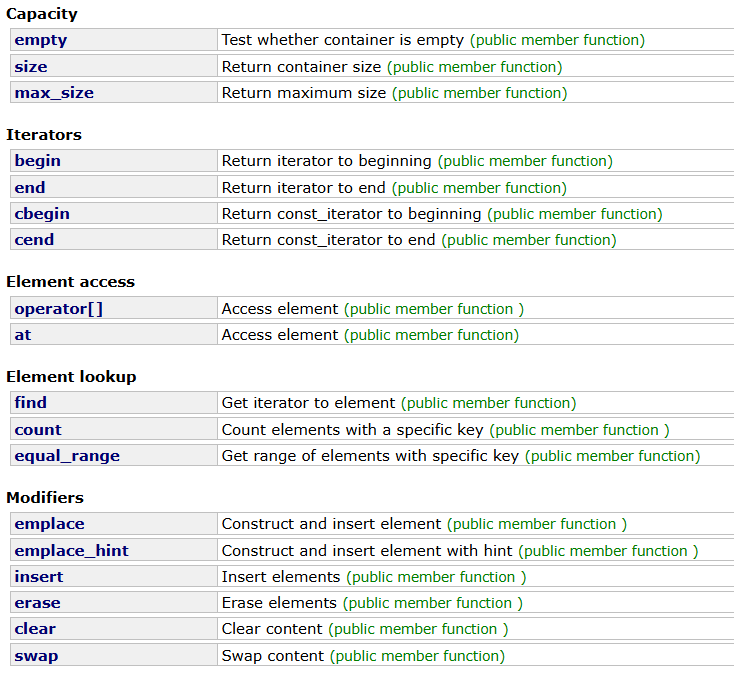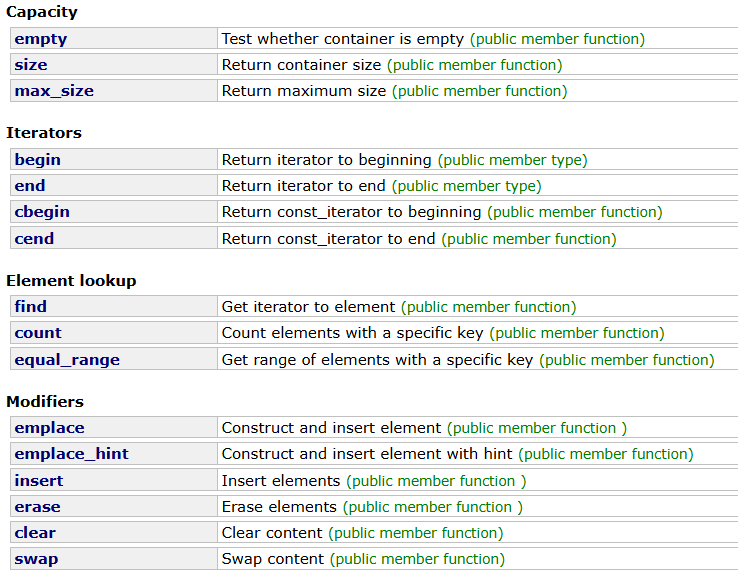【探寻C++之旅】第十六章:unordered系列的认识与模拟实现

请君浏览
- 前言
- 1. 了解unordered系列
- 1.1 初步认识
- 1.2 核心差异
- 1.3 使用示例
- 1.4 与普通 map/set的区别
- 2. 模拟实现unordered系列
- 2.1 迭代器
- 尾声
前言
今天,我们继续踏入追寻C++的冒险历程。上一章我们讲解了数据结构哈希表,那么本章让我们用哈希表来模拟实现一下C++STL中的unordered_map和unordered_set。下面让我们一起来进入本章的学习。
1. 了解unordered系列
在 C++ STL(标准模板库)中,unordered_map 和 unordered_set 是两种基于哈希表(Hash Table) 实现的关联式容器,核心特点是无序存储、平均时间复杂度 O (1) 的增删查操作,但需注意哈希冲突对性能的影响。二者设计目标不同(键值对存储 vs 单一值存储),但底层原理和核心特性高度相似。
1.1 初步认识
unordered_set:
unordered_set的声明如下,Key就是unordered_set底层关键字的类型
template < class Key, // unordered_set::key_type/value_typeclass Hash = hash<Key>, // unordered_set::hasherclass Pred = equal_to<Key>, // unordered_set::key_equalclass Alloc = allocator<Key> // unordered_set::allocator_type
> class unordered_set;
unordered_set默认要求Key⽀持转换为整形,如果不⽀持或者想按⾃⼰的需求⾛可以⾃⾏实现⽀持将Key转成整形的仿函数传给第⼆个模板参数unordered_set默认要求Key⽀持⽐较相等,如果不⽀持或者想按⾃⼰的需求⾛可以⾃⾏实现⽀持将Key⽐较相等的仿函数传给第三个模板参数unordered_set底层存储数据的内存是从空间配置器申请的,如果需要可以⾃⼰实现内存池,传给第四个参数。
⼀般情况下,我们都不需要传后三个模板参数。unordered_set迭代器遍历不再有序,为了跟set区分,所以取名unordered_set。前⾯部分我们已经学习了set容器的使⽤,set和unordered_set的功能⾼度相似,只是底层结构不同,有⼀些性能和使⽤的差异,下面会讲他们的差异部分。
unordered_map:
unoredered_map的声明如下:
template < class Key, // unordered_map::key_typeclass T, // unordered_map::mapped_typeclass Hash = hash<Key>, // unordered_map::hasherclass Pred = equal_to<Key>, // unordered_map::key_equal
> class unordered_map;
unordered_map 和 unordered_set 共享相同的底层实现逻辑 ——链式哈希表(哈希桶),这决定了它们的共同特性:
存储结构:哈希桶(Hash Bucket)
底层由「数组 + 链表 / 红黑树」组成:
- 哈希数组(桶数组):数组的每个元素称为一个「桶(Bucket)」,桶的索引由「键的哈希值 % 桶数组大小」计算得出;
- 解决哈希冲突:当两个不同的键计算出相同的桶索引时(哈希冲突),桶内会通过「链表」存储冲突元素(C++11 后部分实现会在链表长度超过阈值时转为红黑树,进一步优化查询效率)。
这种结构的核心优势是:平均情况下,增删查操作的时间复杂度为 O (1)(直接通过哈希值定位桶,再遍历桶内短链表);最坏情况(所有键哈希冲突)下复杂度为 O (n)(退化为单链表遍历)。
无序性:
与 map/set(基于红黑树实现,有序存储)不同,unordered_map/unordered_set 的元素不按键的大小排序,存储顺序完全由键的哈希值决定,因此遍历结果是 “随机无序” 的。
键的唯一性:
二者均要求「键(Key)不可重复」:
- 插入已存在的键时,
insert函数会返回pair<iterator, bool>,其中bool为false,表示插入失败,迭代器指向已存在的旧键; - 无法通过任何接口修改已插入的键(
unordered_map的键被封装为const K,unordered_set的值本身就是键),只能删除后重新插入。
哈希函数与自定义键:
默认情况下,二者使用 STL 提供的 std::hash 模板计算键的哈希值(支持 int、string、double 等基础类型);若存储自定义类型(如自定义结构体),需手动提供哈希函数(通过模板参数传入,如 unordered_map<MyStruct, int, MyHashFunc>),同时确保哈希函数满足:
- 相同的键必须生成相同的哈希值;
- 不同的键尽量生成不同的哈希值(减少冲突)。
1.2 核心差异
存储内容与使用场景:
unordered_map 和 unordered_set 的本质区别在于存储的元素类型,这直接决定了它们的使用场景:
| 特性 | unordered_map | unordered_set |
|---|---|---|
| 存储元素 | 键值对(std::pair<const K, V>) | 单一值(const K,值即键) |
| 核心功能 | 通过键快速查找对应的值(键值映射) | 快速判断一个值是否存在(去重、判重) |
| 关键接口差异 | 支持 operator[](通过键访问 / 修改值) | 无 operator[](仅需判断值是否存在) |
| 迭代器解引用结果 | 指向键值对(pair<const K, V>),可通过 ->first 访问键、->second 访问值 | 指向单一值(const K),解引用直接得到键 |
| 典型使用场景 | 字典(如单词 - 翻译映射)、缓存(如 ID - 用户信息映射) | 去重(如统计数组中不重复元素)、快速判重(如判断用户是否在黑名单) |
1.3 使用示例
unordered_map 常用接口:

示例:
#include <iostream>
#include <unordered_map>
#include <string>
using namespace std;int main() {// 1. 定义 unordered_map(键:string,值:int)unordered_map<string, int> score_map;// 2. 插入键值对(三种方式)score_map.insert({"Alice", 95}); // 列表初始化score_map.insert(pair<string, int>("Bob", 88)); // pair 构造score_map["Charlie"] = 92; // operator[] 插入(不存在则新建,存在则修改值)// 3. 查找键(find 返回迭代器,未找到则返回 end())auto it = score_map.find("Bob");if (it != score_map.end()) {cout << "Bob's score: " << it->second << endl; // 访问值:it->second}// 4. 修改值(通过 operator[] 或迭代器)score_map["Bob"] = 90; // operator[] 直接修改it->second = 90; // 迭代器修改(需确保迭代器有效)// 5. 遍历(无序)for (const auto& kv : score_map) {cout << kv.first << ": " << kv.second << endl; // kv.first 是键,kv.second 是值}// 6. 删除键score_map.erase("Charlie");return 0;
}
unordered_set 常用接口:

示例:
#include <iostream>
#include <unordered_set>
#include <vector>
using namespace std;int main() {// 1. 定义 unordered_set(存储 int 类型,值即键)unordered_set<int> num_set;// 2. 插入值(去重特性:重复值插入失败)vector<int> nums = {3, 1, 4, 1, 5, 9, 2, 6, 5};for (int num : nums) {auto ret = num_set.insert(num); // 返回 pair<iterator, bool>if (!ret.second) {cout << "值 " << num << " 已存在,插入失败" << endl;}}// 3. 查找值(判断是否存在)if (num_set.count(5)) { // count 返回 0(不存在)或 1(存在)cout << "值 5 存在于集合中" << endl;}// 4. 遍历(无序,去重后结果)for (int num : num_set) {cout << num << " "; // 直接访问值(即键)}cout << endl;// 5. 删除值num_set.erase(9);return 0;
}
1.4 与普通 map/set的区别
在 C++ STL 中,unordered_map/unordered_set(统称「unordered 系列」)与 map/set(统称「普通有序系列」)是两组功能相似但设计原理完全不同的关联式容器,他们的底层差异是他们差异的根源:
| 容器系列 | 底层数据结构 | 核心设计目标 |
|---|---|---|
| unordered 系列 | 链式哈希表(哈希桶) | 追求「快速增删查」,以空间换时间 |
| 普通有序系列 | 红黑树(自平衡二叉搜索树) | 追求「有序存储」,兼顾效率与排序 |
那么我们该如何根据使用场景去选择正确的容器呢?
两组容器没有「绝对优劣」,选择的核心是匹配需求优先级,以下是典型场景的选择逻辑:
| 需求优先级 | 推荐容器 | 原因 |
|---|---|---|
| 追求增删查的效率(O(1)) | unordered_map/unordered_set | 哈希表平均复杂度更低,适合数据量大、对效率敏感的场景 |
| 需要有序存储(如按键排序遍历) | map/set | 红黑树天然有序,支持 lower_bound/upper_bound 等范围查询接口 |
| 存储自定义类型且不愿写哈希函数 | map/set | 仅需重载 < 运算符(红黑树排序用),无需自定义哈希函数 |
| 内存占用敏感 | map/set | 哈希表需预留桶数组空间(通常有负载因子,如 0.7),内存利用率略低 |
2. 模拟实现unordered系列
我们已经对unordered系列有了了解,那么接下来我们就像之前用红黑树模拟实现map/set一样,我们使用哈希表来模拟实现一下unordered系列。
其次跟map和set相⽐⽽⾔unordered系列的模拟实现类结构更复杂⼀点,但是⼤框架和思路是完全类似的。因为HashTable实现了泛型不知道T参数到底是K,还是pair<K, V>,那么insert内部进⾏插⼊时要⽤K对象转换成整形取模和K⽐较相等,因为pair的value不参与计算取模,且默认⽀持的是key和value⼀起⽐较相等,我们需要时的任何时候只需要⽐较K对象,所以我们在unordered_map和unordered_set层分别实现⼀个MapKeyOfT和SetKeyOfT的仿函数传给HashTable的KeyOfT,然后HashTable中通过KeyOfT仿函数取出T类型对象中的K对象,再转换成整形取模和K⽐较相等。这一点与前面的map和set是类似的。
其实大体的思路与之前的思路相同,只是在封装迭代器以及细节方面与之前有些差异。因此我们重点来看一看迭代器的实现。
2.1 迭代器
unordered系列的iterator实现的⼤框架跟list的iterator思路是⼀致的,⽤⼀个类型封装结点的指针,再通过重载运算符实现,迭代器像指针⼀样访问的⾏为,要注意的是哈希表的迭代器是单向迭代器。这⾥的难点是operator++的实现。iterator中有⼀个指向结点的指针,如果当前桶下⾯还有结点,则结点的指针指向下⼀个结点即可。如果当前桶⾛完了,则需要想办法计算找到下⼀个桶。这⾥的难点是反⽽是结构设计的问题,因此在iterator中除了有结点的指针,还需要有哈希表对象的指针,这样当前桶⾛完了,要计算下⼀个桶就相对容易多了,⽤key值计算出当前桶位置,依次往后找下⼀个不为空的桶即可。下面是代码实例:
template<class K, class T, class Ref, class Ptr, class KeyOfT, class Hash>
struct HTIterator
{typedef HashNode<T> Node;typedef HTIterator<K, T, Ref, Ptr, KeyOfT, Hash> Self;Node* _node;const HashTable<K, T, KeyOfT, Hash>* _pht; //...Self& operator++(){if (_node->_next){_node = _node->_next;}else{KeyOfT kot;Hash hs;size_t hashi = hs(kot(_node->_data)) % _pht->_tables.size() + 1;while (hashi < _pht->_tables.size()){if (_pht->_tables[hashi]){_node = _pht->_tables[hashi];break;}hashi++;}if (hashi == _pht->_tables.size()){_node = nullptr;}}return *this;}
}
begin()返回第⼀个桶中第⼀个节点指针构造的迭代器,这⾥end()返回迭代器可以⽤空表⽰。

至于其他的小细节例如通过模板参数Ref和Ptr来实现iterator和const_iterator以及使用模板参数T来代表底层的数据类型,模板参数K来进行find和erase等等细节与我们使用红黑树实现map和set是几乎完全一样的,这里就不再赘述,下面直接给出完整的代码实现:
-
hash_bucket.h
#pragma once#include<iostream> #include<string> #include<vector> using namespace std;template<class K> struct HashFunc {size_t operator()(const K& key){return (size_t)key;} };//特化 template<> struct HashFunc<string> {size_t operator()(const string& s){size_t ret = 0;//这⾥我们使⽤BKDR哈希的思路,⽤上次的计算结果去乘以⼀个质数,这个质数⼀般取31, 131等效果会⽐较好for (auto e : s){ret *= 31;ret += e;}return ret;} };namespace hash_bucket {template<class T>struct HashNode{HashNode<T>* _next;T _data;HashNode(const T& data): _data(data), _next(nullptr){}};template<class K, class T, class KeyOfT, class Hash>class HashTable;template<class K, class T, class Ref, class Ptr, class KeyOfT, class Hash>struct HTIterator{typedef HashNode<T> Node;typedef HTIterator<K, T, Ref, Ptr, KeyOfT, Hash> Self;Node* _node;const HashTable<K, T, KeyOfT, Hash>* _pht;HTIterator(Node* node, const HashTable<K, T, KeyOfT, Hash>* pht): _node(node), _pht(pht){}Ref operator*(){return _node->_data;}Ptr operator->(){return &_node->_data;}//单向迭代器Self& operator++(){if (_node->_next){_node = _node->_next;}else{KeyOfT kot;Hash hs;size_t hashi = hs(kot(_node->_data)) % _pht->_tables.size() + 1;while (hashi < _pht->_tables.size()){if (_pht->_tables[hashi]){_node = _pht->_tables[hashi];break;}hashi++;}if (hashi == _pht->_tables.size()){_node = nullptr;}}return *this;}bool operator!=(const Self& self){return self._node != _node;}bool operator==(const Self& self){return self._node == _node;}};template<class K, class T, class KeyOfT, class Hash>class HashTable{//友元声明template<class K, class T, class Ref, class Ptr, class KeyOfT, class Hash>friend struct HTIterator;typedef HashNode<T> Node;inline unsigned long __stl_next_prime(unsigned long n){static const int __stl_num_primes = 28;static const unsigned long __stl_prime_list[__stl_num_primes] ={53, 97, 193, 389, 769,1543, 3079, 6151, 12289, 24593,49157, 98317, 196613, 393241, 786433,1572869, 3145739, 6291469, 12582917, 25165843,50331653, 100663319, 201326611, 402653189, 805306457,1610612741, 3221225473, 4294967291};const unsigned long* first = __stl_prime_list;const unsigned long* last = __stl_prime_list +__stl_num_primes;const unsigned long* pos = lower_bound(first, last, n);return pos == last ? *(last - 1) : *pos;}public:typedef HTIterator<K, T, T&, T*, KeyOfT, Hash> Iterator;typedef HTIterator<K, T, const T&, const T*, KeyOfT, Hash> ConstIterator;HashTable(){_tables.resize(__stl_next_prime(0), nullptr);}~HashTable(){for (size_t i = 0; i < _tables.size(); i++){Node* cur = _tables[i];while (cur){Node* tmp = cur;cur = cur->_next;delete tmp;}_tables[i] = nullptr;}}Iterator End(){return Iterator(nullptr, this);}Iterator Begin(){if (_n == 0){return End();}for (int i = 0; i < _tables.size(); i++){if (_tables[i]){return Iterator(_tables[i], this);}}return End();}ConstIterator End() const{return Iterator(nullptr, this);}ConstIterator Begin() const{if (_n == 0){return End();}for (int i = 0; i < _tables.size(); i++){if (_tables[i]){return Iterator(_tables[i], this);}}return End();}pair<Iterator, bool> Insert(const T& data){KeyOfT kot;Hash hs;Iterator it = Find(kot(data));if (it != End()){return { it, false };}//扩容if ((double)_n / _tables.size() >= 0.75){vector<Node*> newtables(__stl_next_prime(_tables.size() + 1), nullptr);for (int i = 0; i < _tables.size(); i++){Node* cur = _tables[i];while (cur){Node* next = cur->_next;size_t hashi = hs(kot(cur->_data)) % newtables.size();cur->_next = newtables[hashi];newtables[hashi] = cur;cur = next;}}_tables.swap(newtables);}size_t hash_i = hs(kot(data)) % _tables.size();Node* newnode = new Node(data);newnode->_next = _tables[hash_i];_tables[hash_i] = newnode;++_n;return { Iterator(newnode, this), true};}Iterator Find(const K& key){Hash hs;KeyOfT kot;size_t hashi = hs(key) % _tables.size();Node* cur = _tables[hashi];while (cur){if (kot(cur->_data) == key){return Iterator(cur, this);}cur = cur->_next;}return End();}bool Erase(const K& key){Hash hs;KeyOfT kot;size_t hashi = hs(key) % _tables.size();Node* cur = _tables[hashi];Node* prev = nullptr;while (cur){if (kot(cur->_data) == key){if (prev == nullptr){_tables[hashi] = cur->_next;}else{prev->_next = cur->_next;}delete cur;--_n;return true;}prev = cur;cur = cur->_next;}return false;}private: //指针数组vector<Node*> _tables; //表中存储数据个数size_t _n = 0; }; } -
unordered_map
#pragma once #include"hash_bucket.h"namespace hcy {template<class K, class V, class Hash = HashFunc<K>>class unordered_map{struct MapKeyOfT{const K& operator()(const pair<K, V>& kv){return kv.first;}};public:typedef typename hash_bucket::HashTable<K, pair<const K, V>, MapKeyOfT, Hash>::Iterator iterator;typedef typename hash_bucket::HashTable<K, pair<const K, V>, MapKeyOfT, Hash>::ConstIterator const_iterator;iterator begin(){return _ht.Begin();}iterator end(){return _ht.End();}const_iterator begin() const{return _ht.Begin();}const_iterator end() const{return _ht.End();}pair<iterator, bool> insert(const pair<K, V>& kv){return _ht.Insert(kv);}iterator find(const K& key){return _ht.Find();}bool erase(const K& key){return _ht.Erase();}V& operator[](const K& key){pair<iterator, bool> ret = _ht.Insert({ key, V() });return ret.first->second;}private:hash_bucket::HashTable<K, pair<const K, V>, MapKeyOfT, Hash> _ht;}; } -
unordered_set
#pragma once #include"hash_bucket.h"namespace hcy {template<class K, class Hash = HashFunc<K>>class unordered_set{struct SetKeyOfT{const K& operator()(const K& key){return key;}};public:typedef typename hash_bucket::HashTable<K, const K, SetKeyOfT, Hash>::Iterator iterator;typedef typename hash_bucket::HashTable<K, const K, SetKeyOfT, Hash>::ConstIterator const_iterator;iterator begin(){return _ht.Begin();}iterator end(){return _ht.End();}const_iterator begin() const{return _ht.Begin();}const_iterator end() const{return _ht.End();}pair<iterator, bool> insert(const K& key){ return _ht.Insert(key);}iterator find(const K& key){return _ht.Find();}bool erase(const K& key){return _ht.Erase();}private:hash_bucket::HashTable<K, const K, SetKeyOfT, Hash> _ht;}; }
下面让我们通过一些示例来看一看我们自己模拟实现的unordered系列是否可以正常使用:
#include"unordered_set.h"
#include"unordered_map.h"void test_map()
{hcy::unordered_map<string, string> dict;dict.insert({ "sort", "排序" });dict.insert({ "left", "左边" });dict.insert({ "right", "右边" });dict["left"] = "左边";dict["insert"] = "插入";dict["string"];hcy::unordered_map<string, string>::iterator it = dict.begin();while (it != dict.end()){// 不能修改first,可以修改second//it->first += 'x';it->second += 'x';cout << it->first << ":" << it->second << endl;++it;}cout << endl;
}void test_set()
{hcy::unordered_set<int> s;int a[] = { 4, 2, 6, 1, 3, 5, 15, 7, 16, 14, 3,3,15 };for (auto e : a){s.insert(e);}for (auto e : s){cout << e << " ";}cout << endl;hcy::unordered_set<int>::iterator it = s.begin();while (it != s.end()){// 不⽀持修改//*it += 1;cout << *it << " ";++it;}cout << endl;
}int main()
{test_set();cout << endl;test_map();return 0;
}
我们来看一下运行的结果:

可以看出结果符合我们的预期。那么这就是unordered系列的模拟实现了,希望大家能有些收获。
尾声
若有纰漏或不足之处欢迎大家在评论区留言或者私信,同时也欢迎各位一起探讨学习。感谢您的观看!
